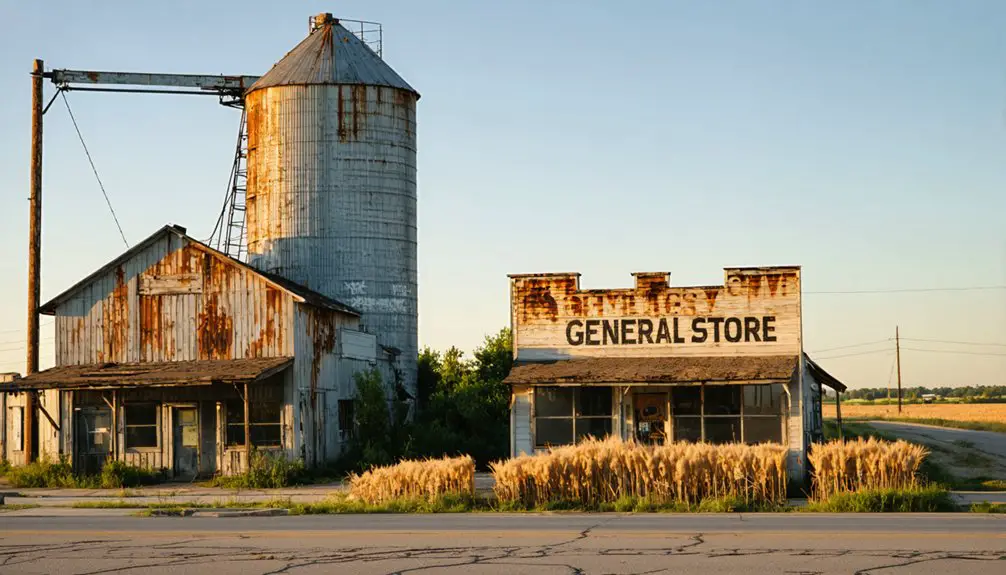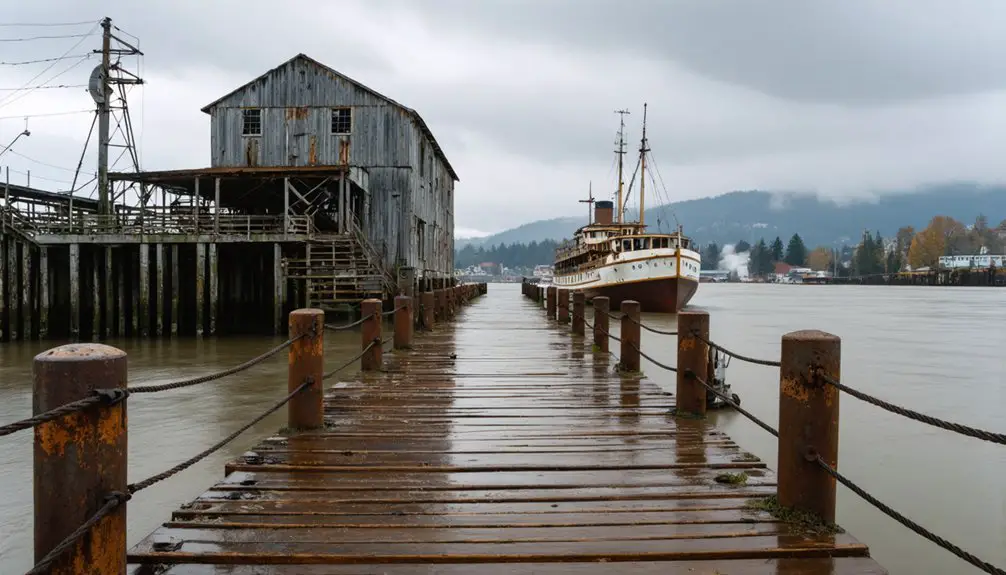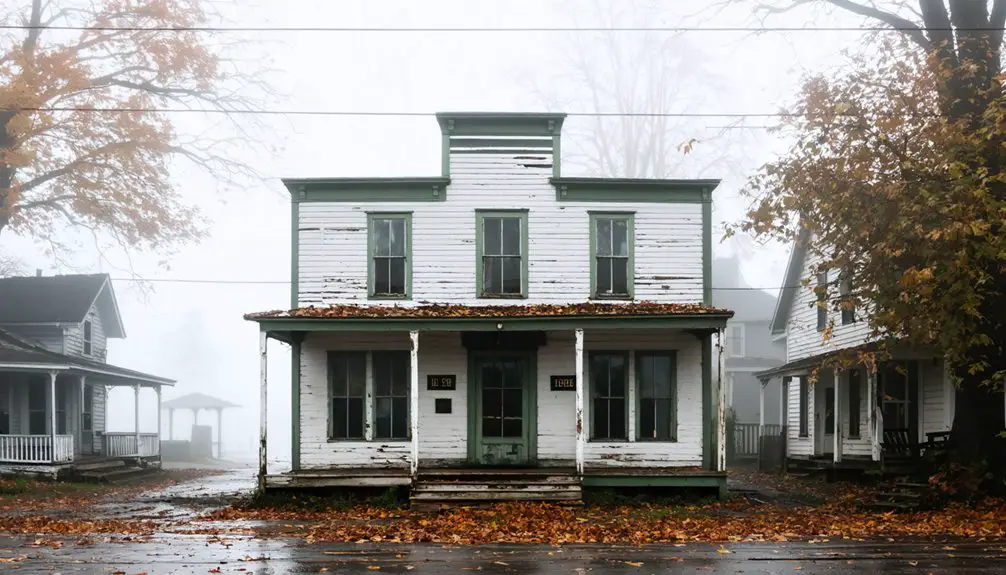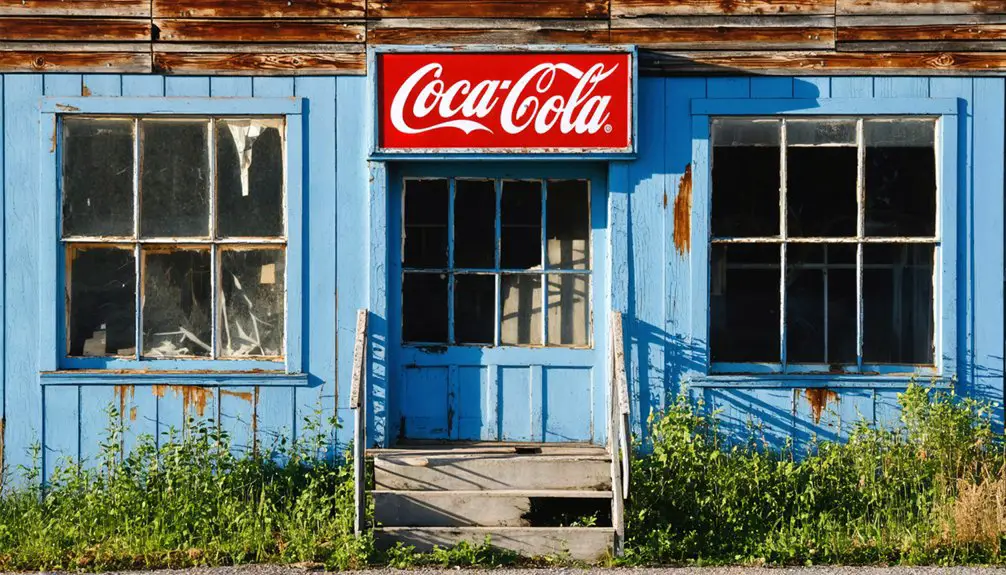You’ll find Butteville, Oregon nestled along the Willamette River, where French-Canadian fur trappers first named it “La Butte” in the 1820s. This former agricultural and shipping powerhouse peaked in the mid-1800s as Oregon’s hops capital, with bustling warehouses and steamboat commerce. While the 1871 arrival of the Oregon & California Railroad diminished its importance, the historic Butteville Store and preserved structures offer glimpses into its prosperous past. The town’s rich heritage of French-Canadian, Native American, and pioneer influences awaits exploration.
Key Takeaways
- Butteville declined from a thriving river port to a near-ghost town after railroads replaced steamboats as the primary transportation method in 1871.
- The historic Butteville Store remains as the most prominent surviving structure from the town’s prosperous trading era.
- Economic decline began with an 1871 mill fire and accelerated when the Willamette Falls locks eliminated the need for river portage.
- Once Oregon’s hops capital and major wheat exporter, Butteville’s population and commercial activity drastically decreased by the early 1900s.
- Modern Butteville maintains minimal residency but preserves its heritage through tourism programs and partnerships with Oregon Parks and Recreation.
Origins of La Butte Settlement
When French-Canadian fur trappers working for the Hudson Bay Company first encountered the small basalt outcropping near the Willamette River in the 1820s, they named the area “La Butte,” meaning “mound” or “hillock” in French.
As retired Hudson Bay Company employees began settling the area, you’ll find the French Canadian influence deeply embedded in the settlement’s early development. The landing became a crucial site when Alexis Aubichon claimed the surrounding land in 1840. The Kalapuya tribes managed the landscape through controlled burning practices to sustain their hunting and gathering lifestyle.
While the settlement was initially called “La Butte” or simply “Butte,” it eventually evolved into Butteville.
The Kalapuya people had long used this strategic river landing before the arrival of European settlers, who established their farms and communities on what became known as French Prairie.
The Rise of a River Trading Hub
From its prime location on the Willamette River, Butteville capitalized on its natural advantages to become the region’s dominant shipping port by 1851.
You’d find steamboats regularly docking at the town’s landing to load wheat, hops, and other agricultural goods bound for distant markets like California.
The town’s elevated position above the flood-prone riverbank proved essential to its success, allowing it to survive the devastating 1861 flood that destroyed its rival Champoeg and solidifying Butteville’s position as the area’s primary trading hub.
The area’s early settlement by French-Canadian fur trappers helped establish the region that would later be known as French Prairie.
Butteville became widely recognized as the hops capital of Oregon during its peak years of agricultural production.
River Commerce Dominates Growth
The advent of stern-wheelers in the early 1850s revolutionized commerce along the upper Willamette River, transforming Butteville into a thriving trade hub.
You’d find over 60 ferry and steamship landings dotting the river upstream of Willamette Falls by 1851, with Canemah emerging as an essential shipbuilding center. The river trade sparked fierce economic rivalry between Butteville and neighboring Champoeg, but Butteville’s elevated position proved pivotal during the Great Flood of 1861, which destroyed much of Champoeg. Today, digital collections help preserve these important historical records.
While Champoeg struggled to recover, Butteville’s strategic location and French Canadian connections helped it dominate regional commerce. The establishment of Fleckenstein’s mercantile store around 1870 further solidified the town’s position as a key trading center.
Grain Shipping Powers Economy
As retired Hudson Bay Company employees began cultivating the fertile French Prairie in the 1830s, Butteville’s identity as a major grain shipping hub took root.
You’d have seen wheat production soar from 5,500 bushels in 1837 to over 10,000 bushels by 1843, establishing essential agricultural exports to Alaska and Hawaii.
The town’s economic transformation accelerated in 1851 when steam-powered sternwheelers began operating on the upper Willamette River.
You would’ve found the waterfront bustling with activity – multiple warehouses storing grain, docks equipped with chutes for loading, and steamboats carrying wheat to Portland markets.
By 1895, the town boasted four stores and warehouses that served the thriving agricultural trade.
The shipping boom fueled local prosperity, supporting churches, schools, and commercial enterprises while spawning ancillary businesses like grain mills and vinegar factories throughout the mid-to-late 19th century.
Strategic Willamette River Location
While many early Oregon settlements struggled to establish reliable trade routes, Butteville’s strategic position on the upper Willamette River proved indispensable for its transformation into a major shipping hub.
You’ll find it perfectly situated between Willamette Falls and the Santiam River confluence, commanding a critical section of river transport in north French Prairie.
Its elevated location on a hill proved pivotal during the devastating 1861 flood that destroyed nearby Champoeg. The town’s position within trade networks connecting Portland, Oregon City, and Salem created natural advantages for commerce.
French-Canadian Heritage and Early Settlers
You’ll find French-Canadian fur trappers, who worked for the Hudson Bay Company, settling in Butteville during the 1820s and 1830s as they shifted from trading to farming.
The area’s name itself reflects this heritage, with “Butteville” deriving from the French term “La Butte,” meaning mound or hillock, referring to a distinctive basalt outcropping near the Willamette River.
These early settlers, many of whom were part of bi-cultural French-Canadian and Native (Metis) families, established the first non-Native year-round settlements above Willamette Falls, laying the foundation for the community’s growth. Catholic priests followed these settlers to provide religious guidance and stability to the growing community.
The settlers used old white winter wheat as their primary source of income, taking advantage of the rich soil in French Prairie to establish successful farms.
Fur Traders’ Early Impact
During the period from 1790 to 1848, fur trading dominated the Oregon Country‘s economic landscape, with Butteville emerging as a notable settlement along important trading routes.
You’ll find that the Hudson’s Bay Company established a powerful monopoly by the mid-1820s, with Fort Vancouver serving as the central trading post that connected to Butteville’s waterways.
The fur trade fostered remarkable cultural exchange as French-Canadian trappers married Native American women, creating influential Métis families. The introduction of European trade goods created new dependencies among Native populations while transforming traditional craft practices.
These unions proved essential to trading success, as Native wives shared significant knowledge of food gathering, clothing production, and tribal relations.
When these fur traders retired, many settled in Butteville with their mixed-heritage families, establishing businesses and becoming community leaders through land claims that shaped the town’s early development.
Cultural Naming Practices
As French-Canadian fur trappers traversed the Willamette River in the 1820s and 1830s, they named a distinctive basalt outcropping “La Butte,” establishing what would become modern-day Butteville.
You’ll find that naming traditions in this area deeply reflect the region’s rich cultural heritage. French-Canadian settlers, many of whom were retired Hudson Bay Company trappers and Métis who’d married into Indigenous families, brought their Catholic faith and bi-cultural practices to the area.
Under Archbishop Francis Norbert Blanchet’s guidance, they established churches that became cultural centers for the community. Their influence extended beyond Butteville to nearby features like Pudding River, while Indigenous place names often merged with French ones, creating a unique linguistic landscape that honored both cultures’ presence in the region.
Settlement Pattern Influences
When French-Canadian fur trappers first settled Butteville and the surrounding French Prairie in the 1820s, they established distinct settlement patterns that would shape the region’s development.
You’ll find their strategic choices reflected in how they positioned homesteads along the Willamette River, maximizing access to water resources and transportation routes.
These early settlers, many of whom married into local Kalapuyan families, created unique bicultural communities that fostered positive community interactions between Native peoples and incoming Americans.
Their land claims, initially informal, became officially recognized after the 1843 Provisional Government formation.
Key figures like Lucier and Gervais secured properties near water bodies and basalt outcroppings, establishing semi-communal agricultural settlements that balanced defense needs with farming priorities.
Life in 19th Century Butteville
Life in 19th century Butteville centered around its bustling waterfront, where stern-wheeler steamboats replaced earlier canoes and flatboats by 1851.
You’d find a thriving community where farmers shipped grain, hops, and apples through the town’s busy docks and warehouses. Community gatherings flourished at the Historic Butteville Store, established in 1863, where you could shop, socialize, and enjoy Henry Weinhard Beer at its famous saloon.
The town’s rich social fabric included an Episcopal church, Masonic and Odd Fellows halls, and a grange hall where agricultural practices were discussed.
You’d encounter local officials like Constable C. Deutcht maintaining order, while various tradespeople, including shoemakers, served the community’s needs.
The tri-weekly stage service connected you to surrounding areas, making Butteville an essential transportation hub within French Prairie.
Economic Growth and Agricultural Impact

During the mid-1800s, Butteville emerged as one of Oregon’s most essential agricultural and shipping hubs, where you’d find farmers producing impressive quantities of wheat and hops.
The community’s agricultural innovations and strategic location on the Willamette River transformed it into a thriving trade center, with steam-powered stern wheelers revolutionizing crop transport after 1851.
Community initiatives helped establish Butteville as Oregon’s “hops capital,” while the region’s farmers expanded their reach:
- By 1837, wheat production exceeded 5,500 bushels, doubling to 10,000 by 1843
- Exports reached markets in Alaska and Hawaii via river shipping
- Over 60 ferry and steamboat landings operated above Willamette Falls
- Local industries expanded to include vinegar production and warehousing
However, the arrival of the Oregon & California Railroad in 1871 gradually shifted trade away from Butteville’s river port.
Town Layout and Historical Buildings
You’ll find Butteville’s original street layout was influenced by early territorial surveys and the critical road to Obeshaw’s Landing, which formed a key boundary line in the town’s development.
The west half of the settlement, claimed by Alexis Aubichon in 1840, bordered the Willamette River, while Joseph LaForte’s eastern portion completed the town’s foundational footprint.
Among the town’s historic structures, the Butteville Store stands as the most significant surviving building, having weathered both time and a 1975 fire to remain operational under Oregon Parks and Recreation management.
Street Grid Design
While Butteville’s original street grid emerged from two separate town plats, its unified design reflected the careful planning of surveyors George Abernathy and Alanson Beers.
The street planning incorporated both residential and commercial needs, with roads strategically positioned to connect Obeshaw’s landing to the town’s essential institutions.
The urban layout’s key features included:
- A practical grid system divided by the Donation Land Claim boundary between Aubichon and Laferie properties
- Streets oriented to provide efficient access to the Willamette River landing points
- Blocks arranged to accommodate public buildings like the Episcopal church, school, and Masonic hall
- Road networks designed to support both residential lots and industrial structures, including the vinegar factory and La Roque warehouse
Structures Through Time
As Butteville emerged as a vital riverport settlement in 1845, George Abernathy’s warehouse marked the beginning of the town’s structural development.
The architectural styles reflected frontier practicality, with wooden buildings housing general stores, blacksmith shops, and hotels serving river travelers. You’ll find the Butteville Store remains the town’s most enduring structure, surviving since those early days despite a 1975 fire.
Churches and schools doubled as venues for community gatherings, while warehouses supported the bustling grain trade.
However, when the railroad arrived in 1905, many buildings fell into decline.
Today, while most original structures have succumbed to time, fire, or floods, you can still visit the historic Butteville Store, now operated by Oregon Parks and Recreation Department, offering a glimpse into the town’s vibrant past.
Transportation and River Commerce

During the mid-1800s, Butteville emerged as an essential transportation hub along the Willamette River, serving French Prairie’s agricultural community through its strategic river landing accessed via Butte Street.
The river routes transformed from simple canoes to powerful steamboats, revolutionizing commerce evolution in the region.
You’ll discover these pivotal developments in Butteville’s transportation history:
- By 1851, over 60 ferry and steamship landings operated above Willamette Falls
- The 1873 completion of Willamette Falls locks eliminated portage requirements
- Twenty-seven steamships were built in nearby Canemah between 1851-1878
- Butteville’s elevated position helped it survive the devastating 1861 flood
The town’s prominence as a shipping center eventually declined when railroads arrived, offering faster and more reliable transportation options through nearby communities like Aurora and Woodburn.
From Prosperity to Decline
Once a thriving agricultural hub established by Methodist missionaries George Abernathy and Alanson Beers, Butteville reached its peak prosperity in the mid-19th century.
You’ll find that by 1878, the town boasted a post office, Episcopal church, Masonic and Odd Fellows halls, and a bustling vinegar factory.
However, you can trace Butteville’s decline to several pivotal events. The 1871 mill fire, which was never rebuilt, marked the beginning of economic challenges.
The devastating 1871 mill fire marked a turning point for Butteville, igniting a series of economic setbacks that would reshape the town’s future.
Despite the community’s resilience, the shift from river trade to railroads proved devastating. Cultural traditions centered around agricultural commerce gradually faded as the town lost its economic importance.
Notable Figures and Community Leaders

The pioneers who shaped Butteville‘s destiny included influential figures from diverse backgrounds. French-Canadian trappers first settled the area before shifting to farming, while Methodist missionaries and merchants followed.
Community contributions from influential families helped establish Butteville as an essential river port and agricultural hub.
- George Abernathy and Alanson Beers surveyed the town’s layout, establishing its foundational blueprint.
- Francis X. Matthieu, both farmer and merchant, cast his historic vote at Champoeg in 1843 to align Oregon with the United States.
- Joseph J. Ryan transformed the Butteville Store into a thriving mercantile center during the town’s commercial peak.
- Joel Palmer documented the significance of La Butte, the basalt formation that gave the town its name, preserving important historical details.
The Friends of Historic Butteville now preserve these pioneers’ legacies.
Preserving Butteville’s Legacy
Modern preservation efforts breathe new life into Butteville’s rich pioneer heritage through collaborative partnerships between Friends of Historic Butteville, Friends of Historic Champoeg, and Oregon Parks and Recreation Department.
You’ll find historical preservation initiatives focused on maintaining iconic structures like the Historic Butteville Store, Oregon’s longest continuously operating retail building.
Community engagement thrives through annual events from Memorial Day to Labor Day, featuring historic reenactments and cultural programming that showcase French Prairie pioneer life.
The town’s connection to Champoeg State Heritage Area via hiking trails enhances visitor accessibility while strengthening its historical significance.
Volunteer efforts, fundraising campaigns, and heritage tourism revenue support ongoing preservation work, from archival collection to building maintenance.
Local volunteers play a vital role in keeping Butteville’s pioneer spirit alive through interpretive programs and site upkeep.
Frequently Asked Questions
Are There Any Remaining Original Buildings Still Standing in Butteville Today?
Through fog-shrouded streets, you’ll find historical preservation has kept a few original pioneer buildings standing, though building restoration records don’t specify exact numbers of surviving structures from Butteville’s heyday.
What Natural Disasters Affected Butteville Throughout Its History?
You’ll find Butteville was hit by the devastating Great Flood of 1861-1862, multiple destructive fires that claimed key buildings, and a violent 1934 Columbus Day windstorm, though there’s no recorded earthquake impact.
How Many People Currently Live in Butteville’s Historic District?
You’ll find that while the current population of Butteville’s historic district isn’t precisely documented, it’s estimated to be fewer than the CDP’s total of 273 residents, preserving its historic significance through limited occupancy.
Can Visitors Access the Original La Butte Hillock Site?
You can access La Butte’s historical site near the Willamette River, though there aren’t formal visitor guidelines. The basalt hillock remains physically accessible via Butte Street and surrounding public areas.
What Archaeological Artifacts Have Been Discovered in the Butteville Area?
You’ll find obsidian arrowheads, settler tools, hop processing equipment, dock hardware, and riverboat remnants through artifacts analysis. These items hold historical significance in documenting indigenous peoples and pioneer commerce.
References
- https://www.armuseum.com/articles/road-trip
- https://www.willametteheritage.org/butteville/
- http://marioncounty20.blogspot.com/2012/08/historic-butteville-champoeg_2.html
- https://butteville.org/history.html
- https://bentoncountymuseums.org/vanished-towns-of-benton-county-oregon-pt-2/
- https://butteville.org/pdf/Butteville-Timeline_panels-11-x-17_Ver-2.pdf
- https://meaderingthroughtheprologue.com/french-prairie-catholiscism-comes-to-the-oregon-country/
- https://johncarroutdoors.com/2012/01/29/champoeg-park-to-butteville-store-an-interesting-journey-through-history/
- https://stateparks.oregon.gov/index.cfm?do=main.loadFile&load=_siteFiles/publications//champoeg-butteville-web.085314.pdf
- https://bestofthenorthwest.com/discover-butteville-or/



